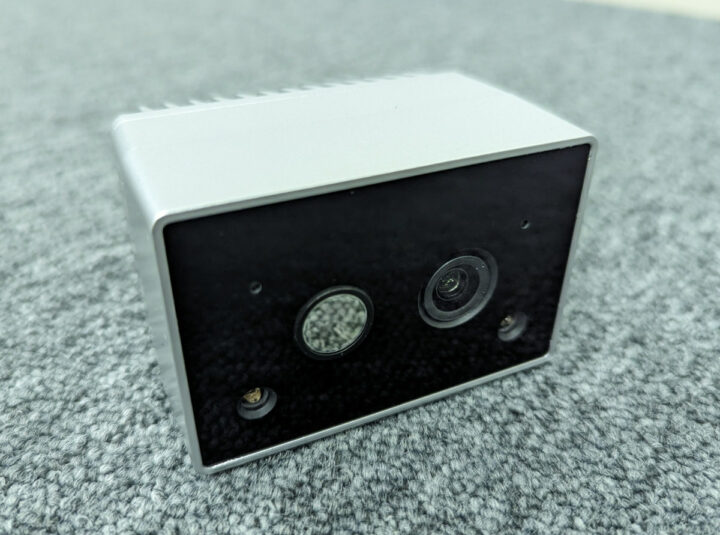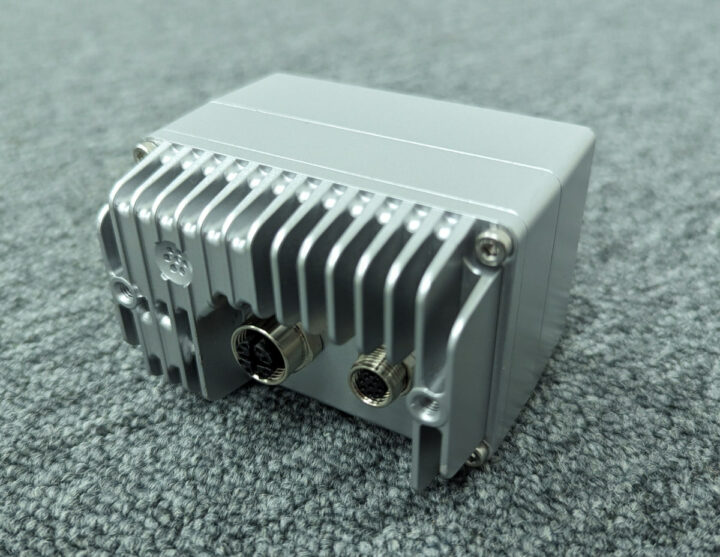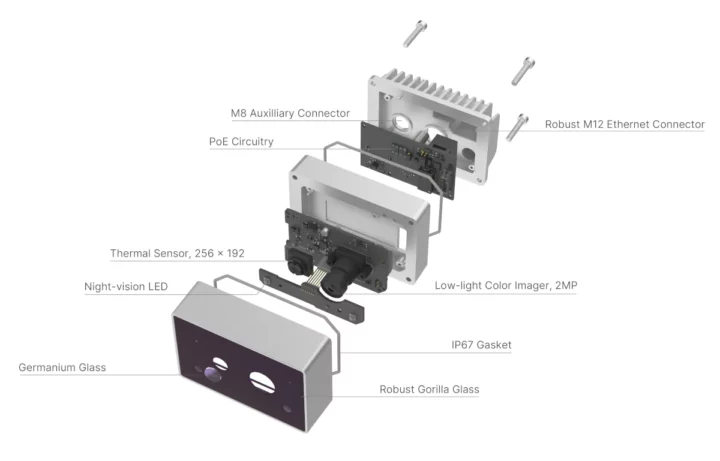Luxonis has announced its first thermal camera with the OAK Thermal (OAK-T) based on the company’s OAK-SoM Pro AI module featuring an Intel Movidius Myriad X, and two waterproof ports with an M12 PoE/Ethernet connector and an M8 auxiliary connector.
Luxonis has been making AI cameras based on Myriad X AI accelerator and its Depth AI solution at least since 2019, and its module is also found in third-party cameras as we’ve recently found out with the Arducam PiNSIGHT AI camera. But they had never made a thermal model, and following customers’ requests to fuse thermal and RGB data, they’ve now developed the OAK Thermal, or OAK-T for shorts, that is suitable for detecting leaks and fires or more accurately detect humans & animals than traditional vision-only based cameras.
OAK Thermal camera specifications:
- System-on-Module – Luxonis OAK-SoM Pro with
- AI accelerator – Intel Movidius Myriad X AI vision processing unit (VPU) with up to 4 TOPS
- Storage – 16 GB eMMC 5.1 flash, 32 MB QSPI NOR flash, 32 kb I2C EEPROM
- Cameras
- Thermal
- Sensor type – Uncooled VOx detector
- Thermal sensor resolution: 256×192
- Measurement range – -15°C – 150°C
- Thermal sensitivity – 50mK @ 25°C and 25Hz
- Thermal Accuracy – ±2°C or ±2% (whichever is larger)
- Spectral range – 8-14µm
- Focus –
- Color – 2.1MP (1920×1080) IMX462 sensor up to 30 fps; focus from 30cm to infinity
- Night vision LED
- Thermal
- Connectivity – M12 Ethernet/PoE connector and M8 auxiliary connector (FSYNC, I2S, GND, GPIO)
- Sensor – Bosch SensorTech BMI270 6-axis IMU sensor with 16-bit tri-axial gyroscope and a 16-bit tri-axial accelerometer
- Power consumption
- Base consumption + PoE circuitry + camera streaming – 3W to 3.5W
- Thermal sensor – ≤1W
- AI subsystem consumption – ≤1W
- Stereo depth pipeline subsystem – ≤0.5W
- Video Encoder subsystem – ≤0.5W
- Maximum – Under 6W
- Dimensions – 80 x 52 x 46mm
- Weight – 297 grams (with metal enclosure)
- Operating Temperature Range – -20°C – 50°C
- IP Rating – IP67
The hardware documentation provides more details about the specifications and wiring of the M12 and M8 connectors. I could not find any software information specific to the new thermal camera, but the Depth AI SDK and Python API documentation will hopefully be updated before launch, and code samples should eventually become available on GitHub.
Luxonis expects the fusion of thermal frames, color frames, and AI models to be especially useful for the following fields and applications:
- Smart agriculture – Health crops, detect irrigation issues, detect pests, livestock health monitoring, etc.
- Industrial monitoring – Detect overheating, detect leaks, detect fires, etc…
- Security – Detect intruders (night vision), detect fires, etc…
- Smart cities/transportation – Detect pedestrians, vehicles, and bicycles for analytics and traffic optimization.
The video below shows the output from the OAK-T camera with a kettle and two cups.
Luxonis OAK Thermal PoE smart camera is up for pre-order for $599 and will start shipping in April 2024 with a 2-meter M12 plug to RJ45 cable, a 2-meter M8 plug male-to-male cable, and a cleaning cloth. More details may also be found in the announcement.

Jean-Luc started CNX Software in 2010 as a part-time endeavor, before quitting his job as a software engineering manager, and starting to write daily news, and reviews full time later in 2011.
Support CNX Software! Donate via cryptocurrencies, become a Patron on Patreon, or purchase goods on Amazon or Aliexpress







